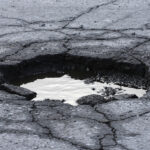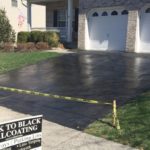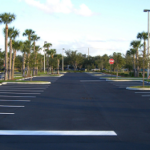Patching Asphalt Driveway
Asphal t is one of the common materials for constructing pavements. Asphalt pavements minimize the on the environment, from the production of the paving material to the placement of the pavement on the road, to rehabilitation, through recycling. Low consumption of energy for production and construction, low emission of greenhouse gases, and conservation of natural resources help to make asphalt the environmental pavement of choice are the reasons why asphalt is the pavement of choice.
t is one of the common materials for constructing pavements. Asphalt pavements minimize the on the environment, from the production of the paving material to the placement of the pavement on the road, to rehabilitation, through recycling. Low consumption of energy for production and construction, low emission of greenhouse gases, and conservation of natural resources help to make asphalt the environmental pavement of choice are the reasons why asphalt is the pavement of choice.
Asphalt patching is a common asphalt repair used on isolated areas of the pavement lot that have cracks, alligatoring, potholes or other forms of pavement damages. Patching is an excellent way to maintain the pavement lot and help prevent more cracks or damages from forming because budgets that are available may not always allow having a reconstruction or a pavement overlay. In addition to that, it will also save future maintenance costs. When water enters the patch and freezes, it expands and enlarges the cracks; therefore each asphalt patching area should be sealed properly as it will help prevent water from entering the new patch. Here are the 5 steps to how to patch asphalt.
Contact preventivesupport.com for pin pile service.
5 Steps to Patch Asphalt
1. Cut Edges and Square Up
The asphalt around a pothole is usually cracked and about to make the hole even bigger, so removing the damaged pavement with asphalt saw or a hammer and chisel (long screwdrivers make great chisels) is required. Also, pothole patching lasts the greatest when you fill a square or rectangle instead of a round or oval hole, so make the edges of the pothole straight up and down. This is where an asphalt saw makes easy work of the job!
2. Clean
Part of knowing how to patch asphalt is to carefully clean out the area. This includes any and all plant life. Pour in some vinegar to completely kill the plant if the roots don’t come out cleanly, and in addition to that, make sure it doesn’t grow through the patch. It is also advisable to remove any and all debris, including the chunks of asphalt you just cut or chiseled out. Go as far down as needed to so an absolutely solid base is obtained. A stiff broom will help get debris out.
3. Repair Foundation
Before pothole patching, it is vital that you must restore the foundation. Top up the hole with a coarse gravel and sand mix until it is only an inch deep. You can also use any loose asphalt that you chiseled out of the pothole. Then, tamp and compress firmly as you fill. To fill a pothole professionally, it must have a solid base to sit on.
4. Fill
For most residential pothole patching concerns, cold asphalt filler is the best material to use. Cold asphalt mix is cheaper, easier to apply, and does not require specialized equipment and skills that are necessary when working with hot asphalt. Add a half to a full inch of driveway patch product and tamp down before adding another layer. This will help guarantee no air spaces that will cause problems later. The last layer should slightly overfill.
5. Tamping Down
Here is where the vibrating plate helps for the finishing of the pothole patching. How to patch asphalt if you don’t have a tamping machine? A lawn roller or metal tamper will work just fine. Or you can just lay a piece of plywood over the repair and drive over it. You can oil the bottom side of the plywood to prevent sticking.
To fill a pothole professionally, you must make it level with the surrounding pavement. If after tamping down the cold patch, it is still not filling the hole, add some more and tamp again. It is necessary to work quickly because this stuff sets quickly and dries hard.
Most potholes are produced due to fatigue of the pavement surface. As the fatigue damages continue to develop, a highly allorgated pattern forms and chunks of pavement between cracks become loose and eventually are removed by continued traffic thus forming a pothole. Until budgets allow for further repairs, a pothole repair is a low-cost effective way to keep up with pavement maintenance. Potholes are a serious tripping hazard and can also cause major vehicle damage thus repairs should be carried out as soon as possible.
Contact us
 Phone Call |
 Text Message |
 |






